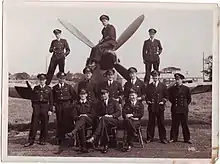| 885 Naval Air Squadron | |
|---|---|
| Active | 1941 1941-1945 |
| Country | |
| Branch | |
| Part of | Fleet Air Arm |

885 Naval Air Squadron (885 NAS) was a Naval Air Squadron of the Royal Navy's Fleet Air Arm. First formed on 1 March 1941, the squadron served as a fighter squadron during the Second World War. It operated in the Mediterranean in 1942–43, where it took part in Operation Torch, the Anglo-American invasion of French North Africa, the Allied invasion of Sicily and the Allied invasion of Italy. In 1944 it took part in the Allied invasion of Normandy, spotting for Allied artillery bombardments and in 1945, was deployed as part of the British Pacific Fleet. It was abolished for the last time on 27 September 1945.
Service
885 Naval Air Squadron was first formed on 1 March 1941 at HMS Grebe in Egypt, also known as RNAS Dhekeila, the pre-war Alexandria airport, as a carrier fighter squadron, equipped with a mix of Brewster Buffalo and Gloster Gladiator fighters.[1] The squadron briefly served aboard the carrier Eagle later that month, but was disbanded on 1 May 1941.[2]
The squadron was reformed at RNAS Yeovilton, equipped with Hawker Sea Hurricane fighters on 1 December 1941.[2] In June 1942, 885 NAS embarked on the carrier Victorious, strengthening the carrier's air wing before Victorious formed part of the distant escort for the disastrous arctic convoy PQ 17 and the return convoy QP 13.[2][3] The squadron re-embarked its six Sea Hurricanes aboard Victorious on 31 July 1942 before the carrier set out to take part in the Malta Convoy Operation Pedestal.[4][5] In September 1942, the squadron was ordered to RAF Machrihanish to re-equip with the Supermarine Seafire IIc, and then embarked on Formidable for Operation Torch, the Anglo-American invasion of French North Africa in November that year.[5][6] The Squadron remained on Formidable as the carrier covered the Allied invasion of Sicily in July 1943 and Operation Avalanche, the Allied landings near Salerno, Italy in September 1943.[2][7][8] The squadron returned to Britain in October 1943 and was disbanded on 15 November 1943.[2]
The squadron reformed again at RNAS Lee-on-Solent on 15 February 1944, again equipped with Seafires. Following the Allied invasion of Normandy on 6 June 1944, the squadron was employed as part of RAF Second Tactical Air Force's air spotting pool, spotting for Allied artillery bombardments as well as escorting shipping in the Channel and carrying out fighter sweeps. In July, 886 and 897 Naval Air Squadrons, both also Seafire-equipped, were merged with 885 Squadron. In November 1944, the squadron re-equipped with Grumman Hellcat fighters in preparation for a transfer to the British Pacific Fleet.[5] The squadron embarked on the escort carrier Ruler in December 1944,[9] with Ruler meeting up with the British Pacific fleet in April 1945.[10] Ruler was tasked with providing fighter and anti submarine protection for the Fleet Train replenishment ships supporting the fleet, with 885 Squadron supplementing its eighteen Hellcats with four Grumman Avenger bombers for anti-submarine duties.[10][11] On 14–15 May, the squadron provided air cover while the British Pacific Fleet replenished during the Battle of Okinawa, with the squadron's aircraft also being used as targets to train the fleet's fighter controllers and anti-aircraft gunners.[12] After the end of Okinawa operations, the squadron disembarked at Ponam Island off New Guinea, providing continuation flying for replacement pilots for the fleet, and temporarily adding some Vought Corsairs while ashore to improve the training it could offer.[13] From June, 885 Squadron operated from Ruler to cover more refuelling operations during operations against Japan.[10][14] The squadron was disbanded at RAAF Station Schofields, near Sydney Australia on 27 September 1945.[9]
References
- ↑ Sturtivant & Ballance 1994, pp. 309, 390
- 1 2 3 4 5 Sturtivant & Ballance 1994, p. 309
- ↑ Apps 1971, p. 83
- ↑ Shores, Cull & Malizia 1991, p. 451
- 1 2 3 Sturtivant & Ballance 1994, pp. 309–310
- ↑ Shores et al. 2016, pp. 48–49
- ↑ Roskill 1960, p. 128
- ↑ Shores et al. 2018, pp. 346–347
- 1 2 Sturtivant & Ballance 1994, p. 310
- 1 2 3 Hobbs 2013, p. 168
- ↑ Hobbs 2017, p. 159
- ↑ Hobbs 2017, pp. 189–190
- ↑ Hobbs 2017, p. 200
- ↑ Hobbs 2017, p. 259
- Apps, Michael (1971). Send Her Victorious. London: William Kimber. ISBN 0-7183-0102-1.
- Hobbs, David (2013). British Aircraft Carriers: Design, Development and Service Histories. Barnsley, UK: Seaforth Publishing. ISBN 978-1-84832-138-0.
- Hobbs, David (2017). The British Pacific Fleet: The Royal Navy's Most Powerful Strike Force. Barnsley, UK: Seaforth Publishing. ISBN 978-1-5267-0283-8.
- Roskill, S. W. (1960). The War at Sea 1939–1945: Volume III The Offensive Part I: 1st June 1943–31st May 1944. History of the Second World War: United Kingdom Military Series. London: Her Majesty's Stationery Office.
- Shores, Christopher; Cull, Brian; Malizia, Nicola (1991). Malta: The Spitfire Year 1942. London: Grub Street. ISBN 0-948817-16-X.
- Shores, Christopher; Massimello, Giovanni; Guest, Russell; Olynyk, Frank; Bock, Winfried (2016). A History of the Mediterranean Air War 1940–1945: Volume Three: Tunisia and the End in Africa: November 1942 – May 1943. London: Grub Street. ISBN 978-1-910690-00-0.
- Shores, Christopher; Massimello, Giovanni; Guest, Russell; Olynyk, Frank; Bock, Winfried; Thomas, Andy (2018). A History of the Mediterranean Air War 1940–1945: Volume Four: Sicily and Italy to the Fall of Rome: 14 May, 1943 – 5 June 1944. London: Grub Street. ISBN 978-1-911621-10-2.
- Sturtivant, Ray; Ballance, Theo (1994). The Squadrons of the Fleet Air Arm. Tonbridge, Kent, UK: Air Britain (Historians) Ltd. ISBN 0-85130-223-8.